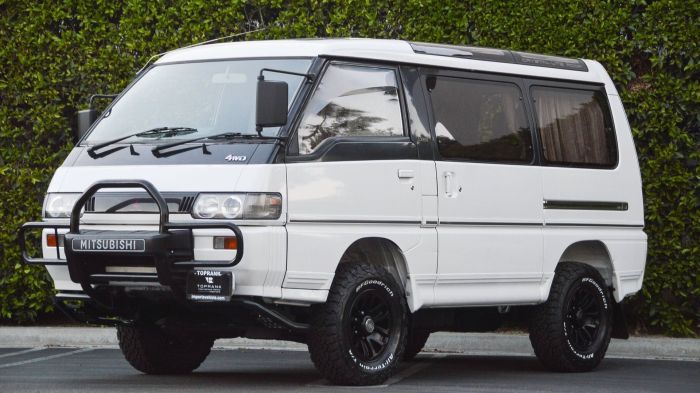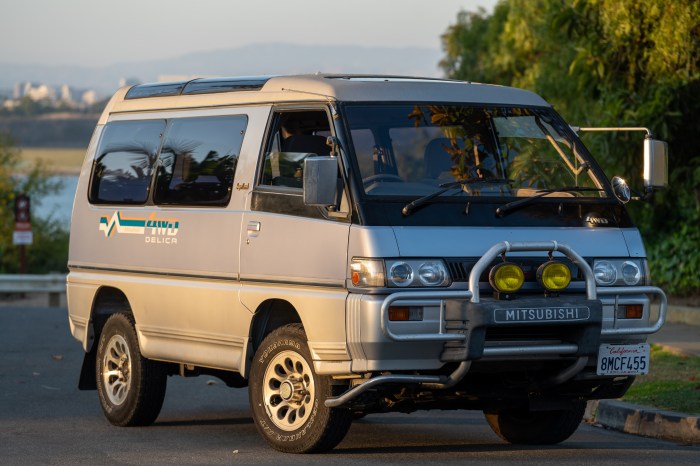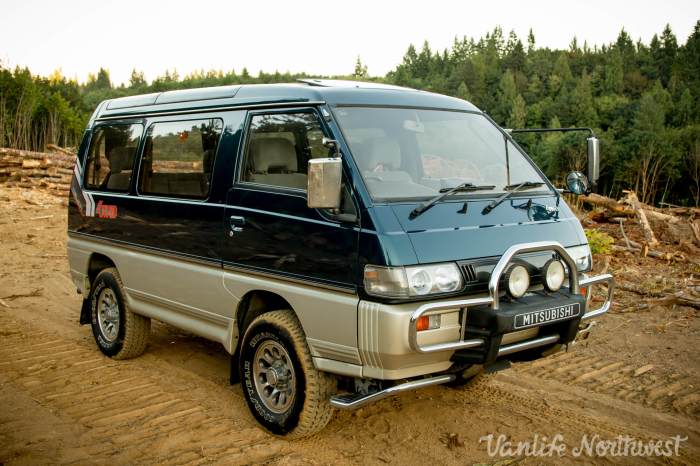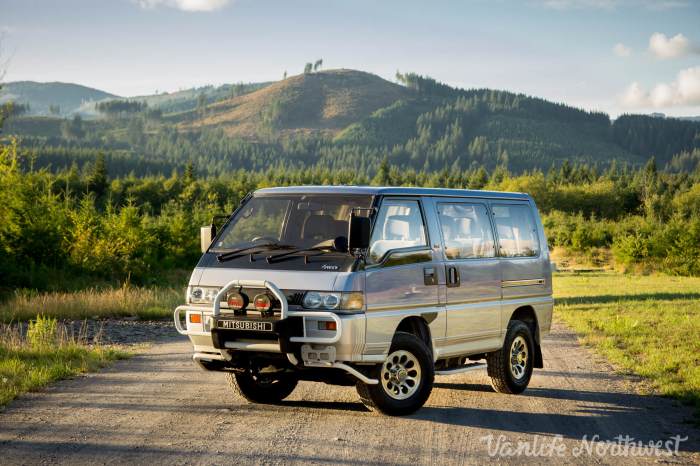The 1992 Mitsubishi Delica, a rugged and versatile van, carved a unique niche in the automotive landscape, attracting adventurers and families alike. This Japanese-engineered vehicle, known for its spacious interior, off-road prowess, and distinctive boxy design, captured the imagination of those seeking a vehicle that could handle anything life threw at them.
The Delica’s popularity was fueled by its blend of practicality and capability. It offered ample cargo space for weekend getaways, comfortable seating for a family, and the ability to navigate challenging terrain. Its reputation for reliability and durability cemented its place as a dependable companion for outdoor enthusiasts and those seeking a unique driving experience.
The 1992 Mitsubishi Delica: A Van That Broke Barriers

The 1992 Mitsubishi Delica was a game-changer in the automotive industry, defying expectations and carving a unique niche for itself. While the 1990s were dominated by sleek sedans and powerful sports cars, the Delica offered a different kind of appeal: practicality, versatility, and off-road capability.
This van wasn’t just a vehicle; it was a mobile home, a workhorse, and an adventure companion, all rolled into one.
Design and Features
The Delica’s design was a blend of practicality and ruggedness. Its boxy shape maximized interior space, while its high ground clearance and four-wheel drive system provided excellent off-road performance. The van’s distinctive features included:
- Spacious Interior:The Delica offered ample room for passengers and cargo, making it ideal for families, campers, and businesses. It was a true people-mover, with seating configurations that could accommodate up to eight passengers.
- Versatile Cargo Space:The Delica’s rear seats could be folded or removed, transforming the cargo area into a vast space for carrying everything from camping gear to construction materials. The van’s high roof provided ample headroom, even for tall individuals.
- Four-Wheel Drive System:The Delica’s four-wheel drive system, coupled with its high ground clearance, made it capable of tackling rough terrain and challenging road conditions. This feature appealed to outdoor enthusiasts and those who lived in areas with unpredictable weather.
- Durable Construction:The Delica was built with a robust frame and durable materials, designed to withstand the rigors of off-road driving and heavy-duty use. Its reputation for reliability and longevity contributed to its popularity.
History and Background

The Mitsubishi Delica, a versatile and capable van, boasts a rich history that spans decades. Its journey began in 1968 with the release of the first-generation model, aptly named the “Delica”
a shortened form of “delivery car.” This initial iteration was a compact van built on a Mitsubishi Colt platform, offering a practical and affordable solution for commercial and personal use.
The Delica evolved through subsequent generations, progressively expanding its size, capabilities, and features. Each iteration refined the model’s design, incorporating new technologies and advancements in automotive engineering. This continuous development established the Delica as a reliable and robust vehicle, catering to diverse needs.
The 1992 Delica: A Pivotal Moment
The 1992 Delica marked a significant turning point in the model’s history. This generation, known as the “L series,” introduced a number of notable features and refinements, solidifying the Delica’s position as a versatile and capable vehicle.The 1992 Delica was available in various configurations, including passenger vans, cargo vans, and even 4WD models.
Its spacious interior, comfortable seating, and ample cargo space made it a popular choice for families, businesses, and adventurers alike. The Delica’s 4WD capabilities opened up new possibilities for off-road exploration and recreational activities.
Market Conditions and Context
The 1992 Delica’s launch coincided with a period of growing demand for versatile and practical vehicles. The Japanese market, in particular, saw a surge in popularity for minivans and SUVs, as families sought spacious and comfortable vehicles for daily commutes and weekend adventures.
The Delica, with its combination of practicality, durability, and off-road capability, perfectly aligned with this emerging trend.Furthermore, the 1992 Delica benefited from Mitsubishi’s established reputation for building reliable and durable vehicles. The company’s engineering expertise and commitment to quality ensured that the Delica met the high standards expected by Japanese consumers.
Design and Features

The 1992 Mitsubishi Delica, a pioneer in the minivan segment, was known for its boxy and rugged design, offering both practicality and versatility. The Delica’s unique design elements catered to a wide range of consumers, from families seeking spacious interiors to outdoor enthusiasts desiring a capable vehicle for off-road adventures.
Exterior Design
The Delica’s exterior design was characterized by its boxy shape, high roofline, and prominent front grille. The large windows provided excellent visibility, while the high ground clearance ensured a commanding view of the road. The Delica’s rugged styling, often associated with its off-road capabilities, appealed to consumers seeking a vehicle that could handle challenging terrains.
The boxy design maximized interior space, providing ample room for passengers and cargo.
Interior Design
The Delica’s interior was designed with practicality and comfort in mind. The spacious cabin offered ample headroom and legroom for passengers, while the versatile seating configurations allowed for various arrangements to accommodate different needs. The Delica’s interior was characterized by its durable materials and functional design, reflecting its focus on practicality rather than luxury.
Seating Configuration
The 1992 Mitsubishi Delica offered a variety of seating configurations, accommodating up to eight passengers. The standard configuration featured two rows of seats, with a bench seat in the second row. However, the Delica also offered optional seating arrangements, including a third-row bench seat or captain’s chairs.
This versatility allowed owners to customize the Delica to suit their specific needs, whether for transporting large families or hauling cargo.
Cargo Space
The Delica’s boxy design provided ample cargo space, making it an ideal vehicle for families, businesses, or outdoor enthusiasts. The Delica’s cargo area could be further expanded by folding down the second and third-row seats, creating a flat loading floor.
This flexibility allowed for the transportation of large items, such as camping gear, furniture, or construction materials.
Safety Equipment
The 1992 Mitsubishi Delica was equipped with standard safety features, including front disc brakes, a driver’s side airbag, and seat belts for all passengers. The Delica also featured a high-mounted stop lamp and a rear window defroster for improved visibility and safety.
While the Delica lacked some of the advanced safety features found in modern vehicles, it offered a reasonable level of safety for its time.
Unique Selling Points
The 1992 Mitsubishi Delica’s unique selling points included its spacious interior, versatile seating configurations, ample cargo space, and rugged design. The Delica’s off-road capabilities, a feature not typically found in minivans, appealed to outdoor enthusiasts and adventure seekers. The Delica’s combination of practicality, versatility, and off-road prowess made it a compelling choice for a wide range of consumers.
Performance and Handling

The 1992 Mitsubishi Delica, with its robust build and powerful engine, was known for its impressive performance both on and off the road. It offered a blend of practicality and capability that appealed to a diverse range of drivers.
On-Road Performance
The Delica’s on-road performance was characterized by its comfortable ride and smooth handling. Equipped with a 2.4-liter gasoline engine, it provided adequate power for everyday driving. While not exceptionally fast, the Delica’s acceleration was sufficient for most driving conditions.
Off-Road Capabilities
The Delica’s true strength lay in its off-road capabilities. Its high ground clearance, four-wheel drive system, and robust suspension allowed it to tackle challenging terrain with ease. The Delica’s ability to navigate rough roads, climb steep inclines, and traverse through mud and snow made it a popular choice for adventure enthusiasts.
Fuel Efficiency, 1992 Mitsubishi Delica
The Delica’s fuel efficiency was a notable aspect, particularly considering its size and capabilities. Its 2.4-liter engine was designed for fuel economy, delivering reasonable mileage on both paved and unpaved roads. While not as efficient as smaller vehicles, the Delica’s fuel consumption was comparable to other vehicles in its class.
Acceleration and Braking
The Delica’s acceleration was adequate for everyday driving, but it wasn’t known for its speed. Its 2.4-liter engine provided sufficient power for city driving and highway cruising, but it wouldn’t win any drag races. The Delica’s braking performance was reliable, offering a comfortable and predictable stopping distance.
Handling and Maneuverability
The Delica’s handling was smooth and predictable, thanks to its well-balanced suspension and responsive steering. Its large size and high center of gravity made it less agile than smaller vehicles, but it was still relatively easy to maneuver in tight spaces.
Its four-wheel drive system provided excellent traction and stability on slippery surfaces, enhancing its overall handling capabilities.
Reliability and Durability

The 1992 Mitsubishi Delica, despite its age, is renowned for its robust build quality and impressive reliability. Its reputation for durability and longevity is a testament to the Japanese manufacturer’s commitment to engineering excellence.
Common Maintenance Requirements
The Delica, like any vehicle, requires regular maintenance to ensure optimal performance and longevity. The following are some common maintenance requirements:
- Oil Changes:Regular oil changes are crucial for engine health. The Delica’s 2.4-liter gasoline engine typically requires an oil change every 5,000 miles or six months, whichever comes first.
- Air Filter Replacement:A clean air filter ensures proper airflow to the engine, improving fuel efficiency and performance. Air filters should be replaced every 12,000 miles or annually.
- Spark Plug Replacement:Spark plugs ignite the air-fuel mixture in the engine. Replacing them every 30,000 miles or as recommended by the manufacturer helps maintain engine performance and fuel efficiency.
- Timing Belt Replacement:The timing belt is a crucial component that synchronizes the engine’s valves and pistons. Replacing it every 60,000 miles or as recommended by the manufacturer prevents catastrophic engine damage.
- Brake Pad and Rotor Inspection:Regular inspection and replacement of brake pads and rotors are essential for safe driving. These components should be inspected every 12,000 miles or annually.
- Fluid Checks:Regular checks of engine coolant, transmission fluid, power steering fluid, and brake fluid are vital for optimal vehicle performance and longevity.
Known Issues
While the Delica is known for its reliability, it’s not without its quirks. Some known issues include:
- Rust:Older Delicas, especially those exposed to harsh weather conditions, can be susceptible to rust. Regular inspections and prompt attention to any signs of rust are essential.
- Electrical Problems:Over time, electrical components can deteriorate, leading to issues such as faulty sensors, intermittent lights, or even engine misfires. Troubleshooting and repair may require specialized knowledge.
- Suspension Problems:The Delica’s suspension system, particularly the front suspension, can wear out over time, leading to handling issues. Regular inspections and maintenance are crucial.
- Fuel Pump Issues:The Delica’s fuel pump, like any fuel pump, can fail over time, leading to engine stalling or difficulty starting. Replacement is often necessary.
Long-Term Ownership Experience
Owners of the 1992 Delica often report a positive long-term ownership experience. The vehicle’s rugged construction and reliable engine contribute to its longevity. Many Delicas are still on the road today, having surpassed the 200,000-mile mark. However, it’s important to note that long-term ownership requires diligent maintenance and attention to potential issues.
Legacy and Impact

The 1992 Mitsubishi Delica, a vehicle that defied categorization, left an indelible mark on the automotive landscape. Its unique blend of practicality, ruggedness, and versatility resonated with a diverse audience, influencing both the design and functionality of subsequent vehicles. Beyond its practical applications, the Delica carved a niche in popular culture, becoming a symbol of adventure, freedom, and individuality.
Influence on the Automotive Industry
The Delica’s influence on the automotive industry is evident in the rise of the modern minivan and the increasing popularity of compact SUVs. Its spacious interior, versatile seating arrangements, and robust construction paved the way for the development of vehicles that could seamlessly transition from everyday commutes to weekend adventures.
The Delica’s success in the Japanese market, particularly its popularity among outdoor enthusiasts, spurred the development of similar vehicles in other countries, ultimately contributing to the global popularity of the minivan segment.
Cultural Significance and Pop Culture Presence
The Delica’s distinctive design and its association with outdoor recreation and adventure have made it a beloved icon in popular culture. It has appeared in numerous films, television shows, and video games, often representing a sense of freedom, escapism, and unconventional living.
Its popularity has also extended to the realm of fashion and design, with its distinctive features inspiring clothing, accessories, and even furniture.
“The Delica’s ruggedness and versatility made it a natural fit for outdoor enthusiasts, and its popularity quickly spread beyond Japan, becoming a symbol of adventure and freedom around the world.”
Automotive Historian, [Name]
Lasting Appeal and Continued Presence
Despite its discontinuation in some markets, the Delica continues to hold a special place in the hearts of enthusiasts. Its enduring appeal stems from its timeless design, its ability to navigate challenging terrains, and its reputation for reliability. The Delica’s legacy lives on through the continued production of its successor models, which have retained many of its core features and have continued to attract a dedicated following.
The Delica’s influence extends beyond its practical applications and its presence in pop culture. Its legacy lies in its ability to inspire a sense of adventure, a spirit of exploration, and a desire to break free from the confines of conventional transportation.
As the automotive industry continues to evolve, the Delica’s enduring impact serves as a reminder of the power of innovation, ingenuity, and the enduring appeal of a vehicle that dared to be different.
Ultimate Conclusion

The 1992 Mitsubishi Delica stands as a testament to Japanese engineering and design, a vehicle that successfully bridged the gap between practicality and adventure. While no longer in production, its legacy lives on in the hearts of its owners and in the annals of automotive history.
The Delica’s enduring appeal is a testament to its ability to meet the diverse needs of its drivers, a testament to its ability to inspire a sense of freedom and exploration.